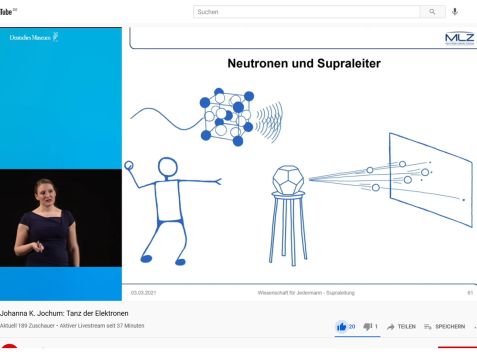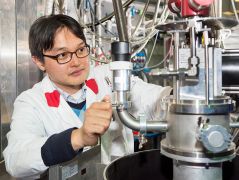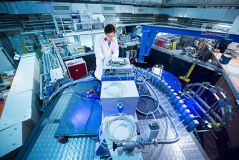MLZ is a cooperation between:
 > Technische Universität München
> Technische Universität München > Helmholtz-Zentrum Hereon
> Helmholtz-Zentrum Hereon
 > Forschungszentrum Jülich
> Forschungszentrum Jülich
MLZ is a member of:
 > LENS
> LENS > ERF-AISBL
> ERF-AISBL
MLZ on social media:

MLZ (eng)
Lichtenbergstr.1
85748 Garching
04.03.2021
Can electrons waltz?
Almost 200 viewers followed Dr. Johanna K. Jochum’s lecture via livestream on Wednesday, March 3. The MLZ scientist gave her lecture titled “Dance of the electrons: Superconductors and their Application” in the series “Science for Everyone” at the Deutsches Museum.
With mostly self-drawn graphics, Dr. Jochum explained how superconductivity was discovered, how the phenomenon works, and how it is applied. Examples of applications such as the one-kilometer-long superconducting cable in Essen and the 12-kilometer-long cable planned for Munich, which will save the amount of electricity consumed by 2,000 households per year, showed the audience the potential of resistance-free power lines.
Prof. Dr. Winfried Petry, long-time Scientific Director of FRM II and MLZ, acted as moderator and summarized the audience’s questions from the live chat. The viewers were interested, for example, in the research possibilities offered by neutrons at the Heinz Maier-Leibnitz Zentrum for superconductivity. The main topic was the “holy grail” of superconductivity research: resistance-free current transport at room temperatures. Dr. Jochum was confident that this would be possible in the future. At any rate, there have been more than 130 publications on superconductivity at MLZ so far, and this research continues with no signs of slowing down. When asked whether electrons are more likely to waltz or pogo in superconductivity, Dr. Jochum said, “As an Austrian, there is no doubt in my mind: Cooper pairs dance Viennese waltzes, of course.”
More information:
For those who want to read again what Dr. Jochum explained or would like to use the graphics, the slides of the talk are available on figshare with DOI: 10.6084/m9.figshare.14156588.v1.
Related News
-
18.05.2016
Reversed symmetry
MLZ is a cooperation between:
 > Technische Universität München
> Technische Universität München > Helmholtz-Zentrum Hereon
> Helmholtz-Zentrum Hereon
 > Forschungszentrum Jülich
> Forschungszentrum Jülich
MLZ is a member of:
 > LENS
> LENS > ERF-AISBL
> ERF-AISBL
MLZ on social media:





